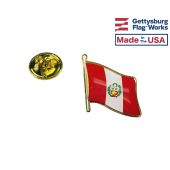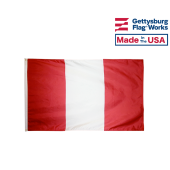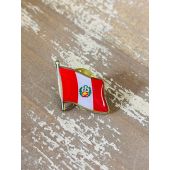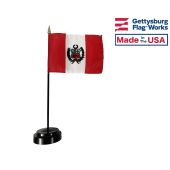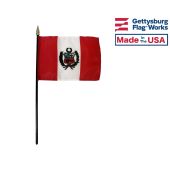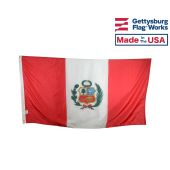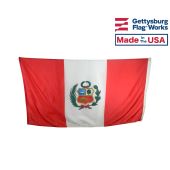Shop Peru Flags & Peruvian Flag Lapel Pins | Fast Shipping
Product Description: Flag of Peru
Peru, a South American nation with a population of over 30 million residents, is a constitutional republic. With an area of 496,225 square miles, it is about 80 percent the size of Alaska, with Lima, the capital and largest city in the country, supporting a population of 9+ million.
The lay of the land
Peru is bordered by Columbia and Ecuador to the north; Chile to the south; Brazil to the east; Bolivia, to the southeast, with nearly 1500 miles of shoreline on the Pacific Ocean to the west.
The country is essentially divided into 3 vastly different geographic regions, divided by the Andes Mountains.
To the east, the area here is heavily forested, sloping leading to the Amazonian plains. Central Peru is mountainous terrain, featuring deep valleys, high plateaus, and peaks exceeding 20,000 feet. To west is the coastline, much of the area very arid.
- Capital of Peru: Lima
- Area of Peru: 1.28 million sq. km
- Languages used in Peru: Spanish (official), Quechua (official), Aymara, many Amazonian languages
- Religions in Peru: Roman Catholic, Seventh Day Adventist, other Christian
Peru flags
Peru, founded on July 28, 1821, officially adopted their flag on February 25, 1825.
The flag of Peru actually has 2 forms, with colors and images on the flags symbolic in their significance.
The permanent national flag is of a vertical triband design, with red outer bands and a single white middle band.
The color red represents blood shed for independence. White symbolizes purity and peace. The colors are believed to symbolize the lasting impact the Incas have had in the country.
The national ensign or state flag (pabellón nacional), used by state institutions, is marked with the coat of arms of Peru (escudo de armas). It is used during ceremonies in which the flag is hoisted in the presence of spectators (as opposed to a static, permanent flag). A form of this flag, the national standard (estandarte nacional) is used indoors by official and private institutions.
The national or civil flag (Spanish: bandera nacional) is used by citizens. It has no additions to the common form. It was changed several times; before 1950 it looked like the current national flag and was used as both the civil and state flag, when General Manuel A. Odría removed the coat of arms from the national flag and created the state and war flags.
The Peruvian Coat of Arms
The Coat of Arms of Peru is located in the center of the red and white triband flag. Used at ceremonies when the flag is raised in the presence of viewers, and at state institutions, it is the national ensign of the country.
In the Coat of Arms, the Cinchona tree, the source of quinine, represents flora.
The vicuna, one of two wild camelids in South America, is a relative of the llama, living in the high alpine regions of the Andes Mountains. On the Coat of Arms, it represents fauna, freedom, heroism, and national pride.
The yellow cornucopia in the Coat of Arms, spilling out gold coins, stands for mineral wealth and prosperity in the country, a blessing Peruvians are honored to symbolize in this way.
The wreath of palm and laurel branches stands for freedom and liberty.
Flag Day in Peru is celebrated on June 7 annually. This date is significant in that this is the anniversary of the Battle of Africa, fought in 1880 between the forces of Peru and Chile.

